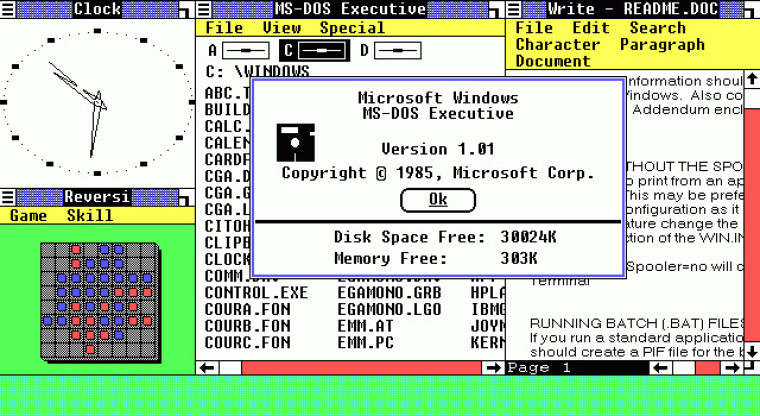
Ten days ago, we wrote a feature that offered a quick look back at the official announcement of Windows 1.0 by Microsoft, 40 years ago on November 10, 1983. We mentioned at the time that Microsoft was planning to actually launch its OS sometime in April 1984.
Unfortunately, that didn't happen. Instead, the PC world had to wait over two years before Microsoft actually put Windows 1.0 (actually Windows 1.01) on sale. That happened 38 years ago today, on November 20, 1985.
We won't go into any of the details about the OS that we discussed in our last feature on Windows 1.0. However, there's lots of evidence that after that initial press event in New York City to reveal the OS, its development hit some early snags.
Technologizer has a column written by Tandy Trower, who was a product manager for the first release of Windows. Previously while at Microsoft, Trower was a product manager for BASIC, and had even managed some of its earliest PC games like the first Flight Simulator. However, he wrote that at one point he had "just gone through one of those infamous grueling project reviews with Bill Gates" about the company's BASIC strategy and how it was getting hit by competitors. He spoke to Steve Ballmer, then the head of product marketing for the company, "and suggested that perhaps I was the wrong person for this job."
Trower then wrote that a couple of weeks after that meeting, Ballmer came back to him and suggested he take over the management of Windows 1.0. By that time, the OS had gotten hit with a "vaporware" and plans to license it to IBM, similar to the license to MS-DOS, didn't work out, with IBM developing its own GUI OS called TopView.
That meant Microsoft would have to sell Windows 1.0 directly to users, which it didn't have to do with MS-DOS. Trower wrote:
Since I had been the product manager that had the most experience with marketing technically oriented products through retail channels (rather licensed to PC vendors), Ballmer thought the job might be a good fit. In addition, he pointed out that since Windows was intended to expand the appeal of PC through its easier-to-use graphical user interface, it should appeal to my more end-user product experience and interests.

Trower accepted the job and joined the Windows team in January 1985. He later suggested to Ballmer and Gates that Windows 1.0 should include a number of small applications to show what the OS could do. When the OS finally shipped, it included a number of apps that are still included in the latest versions of Windows, including Notepad, Paint, Calculator, Clock, and more. There was also a simple word processor program called Write.
However, Windows 1.0 was still not close to being ready to ship, according to Trower, by the summer of 1985. He wrote that Ballmer made the decision to release an early build, which was called the Premiere Edition, to "key application vendors, analysts, and members of the press for feedback".
Trower even mentioned another early Microsoft team member who went onto much bigger things:
We worked all through the summer, typically seven days a week, to finalize things and thoroughly test the code. One of my program managers, Gabe Newell–now the head of the successful game company Valve–would pound on the software until late into the night and morning hours and then sleep in his office.
In the end, Windows 1.01 finally launched 38 years ago today. As we have mentioned before, it was not a critical or sales success for Microsoft, and it wasn't until the release of Windows 3.0 many years later that the OS finally managed to defeat all of the other IBM PC-based GUI operating systems to become the huge product that it is today in the industry.















4 Comments - Add comment